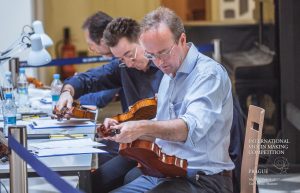Discover what judges prefer in an International Violin Making Competition
2018-01-06



 String Instrument News
String Instrument News

 International Violin Making Competition Jury and luthier Patrick Robin reveal how he evaluates the instruments in the recent competition in Prague.
International Violin Making Competition Jury and luthier Patrick Robin reveal how he evaluates the instruments in the recent competition in Prague.
Robin stated that the first thing that would come to his mind is that if the instrument he examined had great potential to become interesting and good. It might be vague as it sounds but according to Roberts, this is what most luthiers should or would do in making an instrument, and it is challenging to accomplish.
Trying to get into more details, Robin enumerated several points regarding their general impression and concept of a newly crafted instrument. Here are the following points:
- The dimensions of the instrument and its proportions
- The ability to choose high-quality materials. It involves skill in and expertise in selecting the type of spruce and maple that has great potentials to create good mechanism and acoustic. Poplar and Willow are the materials used for cellos and violas.
- The instrument’s shape and arches
- The position of the F holes and its size
- The right quantity of varnish used and its proportions, affecting the thickness and hardness of the wood.
 All of these are the factors he considers as he examines and feels the instrument’s liveliness and weight. According to Robins, these points are the defining factor of the instrument’s character and identity which directly connects to the quality of sound it produces.
All of these are the factors he considers as he examines and feels the instrument’s liveliness and weight. According to Robins, these points are the defining factor of the instrument’s character and identity which directly connects to the quality of sound it produces.
Instrument’s Features for Easy Handling
Another critical thing that Roberts considers the musician’s hands feels their instrument. He observes the arrangements and architecture of the instrument as well as looking at the entire set up without measuring all areas accurately to know how it impacts the production of sound and playability. These are the following features he considers for easy handling.
- The measurement of the string, neck and bridge stop.
- The size and shape of the neck. This involves upper register transition as well as its comfortable grip.
- How the fingerboard attaches to the belly and the bridge’s height. These measurements provide the bow a clear pathway between the C bouts.
- The necks attachment over the belly’s edge
- The height of the low saddle and the strings position on top of the bridge.
- The Bridge’s arch shape, height and the skill of choosing the quality of wood for the bridge including the ability to cut it with the right proportion and quality.
- The fingerboard’s condition involving its shape, smoothness of its finish and its hollow.
- The transition point that the top nut provides for the strings up towards the peg box with suitable string height.
Appreciating the Style and Technique of a Luthier
 Robin stated that they wanted to have a violin that would be part of the great tradition of violin making. This great tradition must continue to live on to make the uniqueness and character of the instrument come out.
Robin stated that they wanted to have a violin that would be part of the great tradition of violin making. This great tradition must continue to live on to make the uniqueness and character of the instrument come out.
He looks at violin making technique as an artwork of sculptural masterpiece and not just creating a good sounding musical instrument. Robin added that a clean and pristine finish is not necessary for displaying a proper technique. However, a well thought-out concept for a new and interesting instrument can be obscured by a rough finish.
Robin said that one can have great technique and a good sense of sculpture but can neglect the cleanliness of the surface. On the other hand, a weak method can be hidden by hours of painstakingly grinding away some rough edges, paying attention to small details until achieving a pleasant and smooth finish.
 For Robin, a technique is having spontaneity and clear ideas under the skill of a talented hand. The significant points are the new ideas and originality.
For Robin, a technique is having spontaneity and clear ideas under the skill of a talented hand. The significant points are the new ideas and originality.
When it comes to the finish, the entirety of it involves ground coat, sculpture, varnish and surface finish.
The varnish is also very important because it must protect the instrument for its day to day use, but it must be too hard.
The Violin’s Sound
Two things strike Robin the most, and that is the physical appearance of the instrument and the way it sounds. Here are some points that he considers.
- The presence of a beautiful and interesting voice.
- Power is essential, but it must partner with a beautiful voice. No one loves to listen to a screaming soprano voice.
- Colors and dynamics must have variation
- The presence of the instrument and how it projects across the hall
- Forte: the sustainability of the instrument under pressure without saturation.
- Balance and equality of the instrument in different registers.
- Ease of speaking
 Finally, Robin considers the source of flaws in the instrument if it came from the problems in the setup or its concept. He said that he is always very considerate and would give a chance on instruments that require improvement on adjustment but has great character.
Finally, Robin considers the source of flaws in the instrument if it came from the problems in the setup or its concept. He said that he is always very considerate and would give a chance on instruments that require improvement on adjustment but has great character.

Leave a Comment